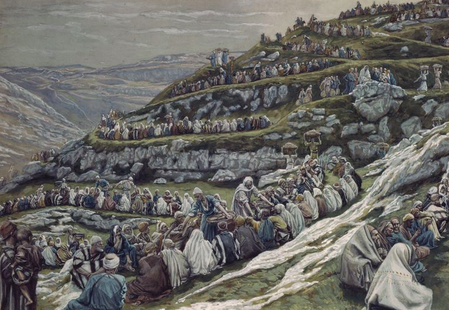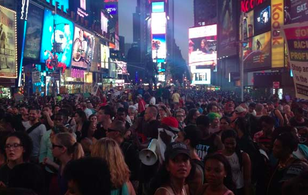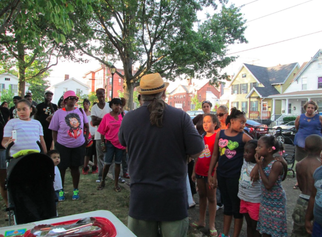III. We demonstrate the presence of the Kingdom by sending Laborers into God’s Field to do what Jesus did We have moved into the Hill. We relocated. (You all made this possible—thank you.) This is important: most pastors of churches in places like the Hill don’t live in the church’s neighborhood. Our moving into the Hill is a big deal—that’s what our neighbors tell, too. This is huge because there is a connection between the gospel and the community . . . between Shepherds and the community . . . between churches and the community. No wonder Jesus calls for laborers for the harvest. Another summary at the end of Matthew 9.
The reason for Jesus’ compassion is that they were sheep without a shepherd, harassed and dispirited. Jesus mixes his metaphors and says that there is a need for Shepherds for the Harvest is rip. “Harvest” is a great eschatological, end time word used throughout the Old Testament. “Harvest” means we are in the age of the appearance of the Kingdom of Heaven, but it also suggests that the end is near (of course eschatologically near, but also timely, the time to harvest is now; this gives us an urgent frame for the task). We should not be surprised that there is a relationship between this crowd of outsiders, unclean, lame, diseased, their condition (harassed and dispirited), and the absence of a Shepherd. People die without a shepherd. This is why we pray to the Lord of the Harvest to send forth laborers, send Shepherds into the field. I am humbled by how I am greeted on our apartment’s street: “Pastor.” “Rev.” “Park Pastor.” My favorite is “Hey, Preach.” But the one that honors me the most is when my neighbors call me, “Pastor of the Hill.” That’s crazy, right? I had just walked out of our apartment front door, heading to my car for a meeting, when I heard, “Pastor, come here.” This happens often. I do not carry cash on me. This is an important rule ministering where I pastor. Usually it is, “Do you have a dollar?” or “I need $8.50 for a bus ticket.” It’s hard, but I need to say, “No, I don’t.” Yet, I am a neighbor. And, a pastor (which most of our neighbors know) . . . so, sometimes I try to find other ways to help. This morning an older gentleman, who lives across the street (he admits his drinking problem and has a hard time walking because of his heart), pulled me in close and whispered to me, “Do you have a bag of groceries?” This is a tough one . . . I gave him my normal reply, but added, “When I get back, I’ll see what I can do to get you some food.” I located a $20 and found him still sitting where I left him. “Let’s go to the corner store and get you $20 bucks worth. No cigarettes though.” We walked slowly, stopping every 25 feet or so for him to catch his breath. Once inside the corner store . . . it was missional . . . a small crowd was there. Some teens shouted, “Hey, Pastor Chip!” I introduced myself to the others. Fist bumps all around. My older neighbor then surprised me when he started introducing me to his friends in the store, “This is my pastor.” Didn't expect that. And, he said it more than once. I held back tears. Of course, there are plenty of food resources, shelters, and food pantries in New Haven, which is my usual go-to reply. But, my presence in the neighborhood isn’t to be a social-worker or case-worker. This is a neighbor, someone I talk to regularly, and to whom I have given some street pastoral counseling—hard to just defer when, in some way, he’s one of my sheep (at least a street sheep). Plus, this man is abused by his boarding roommate, his food stamp-card taken regularly, and his landlord won’t do anything—and complaining just makes it harder on him. All this gentleman knows is his drinking, bad health, and sometimes Jesus shows up as his neighbor who also happens to be hispastor. These good people need a shepherd . . . It is no surprise that immediately after having compassion for the sheep that do not have a shepherd (9:36) and praying for the needed laborers to go harvest (9:337-38), Jesus appoints his twelve and commissions them (10:1-15). Although there is far more to this list (vv. 2-4) and their mission (vv. 5-15), I want to call attention to one thing very much related to our thread: Jesus instructs the twelve to proclaim that the Kingdom of Heaven is at hand (v. 7). Jesus calls the 12 disciples (10:1a) and gives them authority to do exactly what he has been doing (v. 1b)–exactly what they observed in following Jesus around as we have observed thus far. Now, they are to be fisher-followers by casting out demons and healing every disease and every affliction (10:1) and, so, they demonstrate that the kingdom of God is present (v. 7): Heal the sick, raise the dead, cleanse lepers, cast out demons (v. 8a). *This sermon was preached at Redeemer Presbyterian Church in Concord, MA on Sunday, May 19, 2019. The full sermon maybe downloaded as a PDF (here). An audio version is also be available >> Audio version Part I | Part II | Part III | Part IV
0 Comments
Each spring I attempt to write a brief paper for our Northeast Regional Evangelical Theological Society. This year (2016) I thought I’d put together a study on the Synoptic writers’ use of “crowd” (oxlos) in their Gospel narratives. Below is my paper submission abstract and outline, along with a brief reflection on how I came to consider “crowd” as a Gospel character. A Real Time, Messy Missional (Local) Church: What “Crowd” as a Gospel Character Teaches About Being Missional-Church Pastors and lay-teachers tend to be more comfortable focusing on cognitive effects and propositional aspects of the gospels like Jesus’ preaching, parables, and teaching. Characters are another matter in the gospel narratives, for they are more likely to be “identified with” or used as “lessons” in which they tend to be allegorized, devotionalize, or typified rather than seeking how they are used in the story and, thus, developed for their contextual interpretive significance. The “crowd,” on the other hand, is rarely viewed as a character in the Synoptic Gospels and, thus, often not considered for its interpretive value. The “crowd” character presents a difficulty for the interpreter of the Gospel narratives. The “crowd” is that messy, unclear presence at much of Jesus’ ministry—sometimes for Jesus, sometimes against him, occasionally believing, oftentimes unbelieving, and, then, more so, it is split believing and not believing. And what makes the interpretation-application process even more troublesome, often the reader is left just not knowing the crowd’s confessional state of mind. One thing is consistent, however, the “crowd” is almost always present at Jesus’ public activities, teaching, and travels. Conversely, one could posit that Jesus was present among the crowd in much of the Synoptic Gospel narrative. Assuming that the Gospels were written to help local, believing communities to imagine how the gospel was to inform and form their discipleship and missional purpose, the “crowd” has value at the teaching level. What does the Synoptic Gospel crowd reveal about a church’s mission and presence among others? Is our building-centered church experience prohibitive of such crowds? What can the significance of the Synoptic Gospel crowd (as) character tell or instruct us on how we should do church, today? To give this a contemporary social location, the forming significance of “crowd” as a Synoptic Gospel character should be juxtaposed with the forming power of a building-centered church experience and how this affects the missional life of the local church. We should grasp how a building-centered church experience is anti-crowd; the “crowd” as a Gospel character should inform our exegetical-significance-application process; we should observe how the role of “crowd” and its impact in the text informs the missional purpose of a local church; and, the significance of “crowd” shows is what is suitable “space” for a local church. This effort here [in the full paper] seeks to demonstrate (conclude) that a missional-church creates space for crowd to engage the gospel of the kingdom. A preliminary reflection on “crowd  After studying and writing on the Mark 3 Beelzebul passage and “the blasphemy of the Holy Spirit” (it isn’t what you think it is; trust me), I was fascinated by Mark’s use of “crowd” throughout his Gospel. If we take Mark as inspired and his use of “crowd” as a strategic character in the gospel story, it seems to me, we should grasp the crowd’s significance within our understanding of both the gospel and, as well, the (local) church. Obviously more needs to be studied and written on this, but a brief forethought on crowd is worth it as we strive to rethink church. One specific characteristic of the “crowd” worth noting, it is always around Jesus (or Jesus is in the midst of the crowd), meeting and greeting him, listening to him, and sometimes literally jumping over one another to be near to what Jesus was doing or saying. Second, another aspect to grasp, the “crowd” is sometimes believing and sometimes unbelieving, and sometimes, well, you just can’t tell one way or another. Sometimes the “crowd” is even split by belief and unbelief. Yet, the presence of Jesus was marked by the presence of "crowd" (ochlos).  I have come to the conclusion this is the way it should be with the (local) church, which is God’s fullness, Christ’s body local (e.g., Ephesians 1:22). Seriously, as the body of Jesus, the church, that is, a local church, should be surrounded by “crowd” in a similar fashion as Jesus himself was surrounded by “crowd.” We read out such inferences (to “crowd”) in the Gospels and mostly cannot conceive the church’s role in this way. This is one of the negative aspects of our building-centered church habits. We need to stop thinking church as a building, and acting like it is—in fact, a building-centered church experience is prohibitive of this crowd-missional aspect of the church's purpose and, can be, antithetical of gospel. We, as evangelicals, are uncomfortable with crowds “at” church; uncomfortable where the categories of believing and unbelieving are rather foggy. (This does havoc on a high fencing view of communion, for sure.) This suggests we need to rethink church and where “church” (and possibly how it) happens. Whereas the inner circle of followers and disciples (we more comfortably refer to as the church members or regulars attenders) are believing (and sometimes maybe even struggling to believe) and, at differing levels, learning obedience, on the other hand, the outer circle that surrounds the church (and sometimes crowding inside as it were) is a little foggy on the issue of belief. But, they ought to be there—sometimes they’ll look like believers, sometimes they won’t, and sometimes you just will not be able to tell one way or another. We need to see “crowd” around the (local) church as a vital character in the (local) church’s story within the community it seeks to minister and serve. Perhaps more biblically accurate, we should experience church in the midst of “crowd,” for the church is Jesus’ body--and this is what Jesus displayed in the Gospel narratives. |
AuthorChip M. Anderson, advocate for biblical social action; pastor of an urban church plant in the Hill neighborhood of New Haven, CT; husband, father, author, former Greek & NT professor; and, 19 years involved with social action. Archives
February 2024
Categories
All
|
Pages |
More Pages |
|

 RSS Feed
RSS Feed